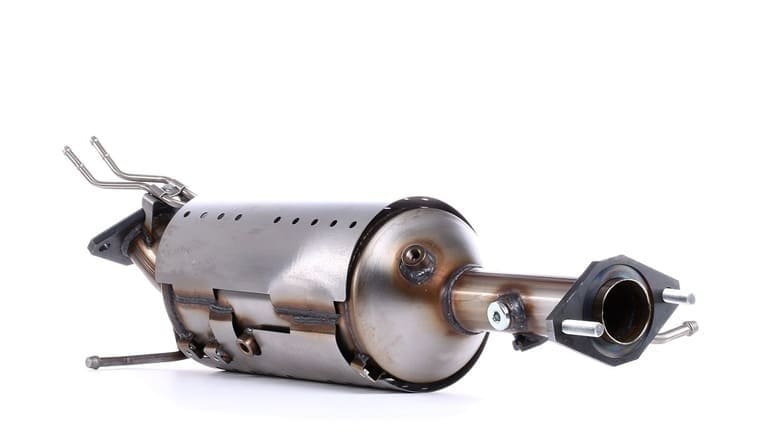
Not only since the diesel scandal did motorists know that a functioning exhaust system is important. It is not without reason that all vehicles are checked regularly – at the latest as part of the general inspection. But how do you recognize if your exhaust system is defective? In the following article, we explain the structure of this important vehicle system and how you can identify a defect in the exhaust system at an early stage. Unfortunately, as is so often the case here, early repair can help to avoid expensive consequential damage.
Contents
What does an exhaust system include?
Many motorists think of a broken exhaust pipe as the first thing that comes to mind when they think of a defect in the exhaust system. But that is only half the truth: your exhaust system includes many other components that are also important for their correct function. We will also explain to you whether you can continue to drive with a defective catalytic converter and what exhaust gas recirculation is actually all about.
Let's start with the structure of a typical exhaust system on the engine, where the combustion gases are produced. These are expelled from the cylinders and absorbed by the mostly cast-iron manifold.

The so-called lambda probe is usually also installed here, which supplies the engine control unit with important information about the completeness of fuel combustion. More precisely, this sensor determines how much oxygen is still contained in the exhaust gases. Due to its complex structure, the exhaust manifold is one of the most expensive components of the exhaust system. The so-called Y-pipe is connected to the manifold, which is responsible for bundling the exhaust gases on the individual combustion chambers. This component is particularly durable, so that defects in this area are extremely rare. In order to decouple the engine vibrations from the exhaust system, the downpipe is followed by the so-called flexible pipe, which is relatively short and consists of a flexible stainless steel mesh. The exhaust gas is cleaned by the catalytic converter after the flexible pipe. The active component is a ceramic inner body, which must be protected against vibrations. If your catalytic converter is defective, you must not continue driving, because an immediate replacement is required. After the catalytic converter, the center pipe leads the pre-cleaned exhaust gases through the integrated center silencer to the rear silencer.

A soot particle filter can be installed in front of the rear silencer, particularly in diesel vehicles. If your vehicle is newer than 2014, there is most likely also a diagnostic probe in the center pipe area. This allows the catalyst function to be checked based on the composition of the exhaust gas. The main purpose of the rear silencer is to reduce engine noise. The so-called muffler has very strong rubber fasteners that connect it to the underbody. This allows it to vibrate slightly and it is possible to reduce the correspondingly acting forces. The exhaust gases are then discharged to the outside through the tailpipe after the rear silencer.
What do you do if the exhaust noise is suddenly louder than normal?
If the car suddenly makes loud noises while driving, you should think about why. First, a systematic analysis is recommended. If there is a problem with the exhaust, the noise will continue even if you stop and let the vehicle engine run. If your vehicle is quiet again, it may not be an exhaust noise at all.
The most common exhaust noise is the classic roar, but where exactly this symptom comes from is not always immediately clear. Because the flex pipe is heavily loaded in several ways (both thermally and mechanically), it fails particularly often. However, the advantage of this type of component failure is that a suitable spare part is usually available very cheaply. The average spare parts prices here start in the range of 15 to 20 euros. Of course, there are also the costs for installation if you have this done in a specialist workshop. Another exhaust component that often suffers a defect is the rear silencer or its attachments or suspension. In many cases, its service life is only a few years. The reason for this is that it is not only exposed to large temperature fluctuations, but also has to withstand the acidic exhaust gases and high humidity. The expense of a change and the cost of spare parts of 100 to 200 euros are still in an area that is easy to cope with.

The situation is different, however, if the catalytic converter is defective. A failure of this component can be expressed not only by poor values in the exhaust gas analysis, but also by a characteristic rumble or rattle. The latter is often due to the fact that the inner workings of the catalytic converter, a ceramic element, is broken and parts of it can bang around loosely. If you notice such symptoms in your vehicle, you should act immediately. Because you not only pollute the environment unnecessarily, but it can even happen that this exhaust system component crumbles completely. The repair is also carried out by replacing a component. The spare parts costs are in the range of two to six hundred euros plus working hours. Depending on the vehicle model, a replacement by a specialist takes one to three hours. It is also important to know that the spare parts are in most cases so-called replacement parts, i.e. you are returning the defective component. You benefit from a correspondingly lower spare parts price. If the soot particle filter is defective, a refurbished replacement part will be installed in most cases.
Can you continue driving with a defective catalytic converter?
This is prohibited by law because your vehicle will no longer meet the relevant limit values for the emitted exhaust gases if the catalytic converter is no longer working properly. In principle, your car also becomes a danger to our environment and you can no longer refer to your type approval. However, you do not necessarily have to have your vehicle towed to the nearest workshop. When driving with a defective or non-existent catalytic converter, it is even conceivable that the state considers the facts of tax evasion to be fulfilled because the limit values of the corresponding Euro standards are no longer met and a significantly higher vehicle tax would have to be paid.
Conclusion
A defective exhaust is more than just a minor annoyance. Repairs can be quite expensive, for example if bolts or screws break off during assembly or disassembly. The repair costs accordingly also extend over a wide range. For example, a spare part for the short flexible pipe costs significantly less than a soot particle filter, catalytic converter or center silencer. In the case of the catalytic converter and soot particle filter, there are also replacement parts or the option of reconditioning them. This can save a lot of money.
A tip from CarTipsandmore: When you get spare parts for your exhaust system, you should be particularly careful not to save at the wrong end. Experience has shown that the permissible tolerances for the components on offer are quite large, so that something quickly does not fit properly. In addition, it is advisable to use a single manufacturer for larger repairs (several exhaust elements have to be replaced). That way, you have a better chance of everything fitting together perfectly. Please also order all required fasteners.
